传统文化翻译
- 格式:doc
- 大小:48.00 KB
- 文档页数:15
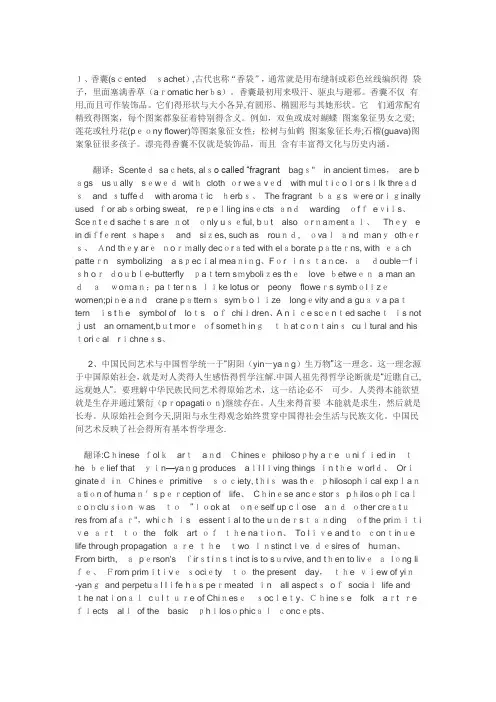
1、香囊(scentedsachet),古代也称“香袋”,通常就是用布缝制或彩色丝线编织得袋子,里面塞满香草(aromatic herbs)。
香囊最初用来吸汗、驱虫与避邪。
香囊不仅有用,而且可作装饰品。
它们得形状与大小各异,有圆形、椭圆形与其她形状。
它们通常配有精致得图案,每个图案都象征着特别得含义。
例如,双鱼或成对蝴蝶图案象征男女之爱;莲花或牡丹花(peony flower)等图案象征女性;松树与仙鹤图案象征长寿;石榴(guava)图案象征很多孩子。
漂亮得香囊不仅就是装饰品,而且含有丰富得文化与历史内涵。
翻译:Scentedsachets, also called “fragrant bags"in ancient times,are b ags usually sewedwithcloth or weaved with multicolor silk thread sand stuffedwith aromaticherbs、The fragrant bags were originally used for absorbing sweat,repelling insects andwardingoffevils、Scented sachets are notonly useful, but also ornamental、They e in different shapesand sizes, such as round,ovaland manyother s、And they arenormally decorated with elaborate patterns, with each pattern symbolizing a special meaning、For instance,adouble-fish ordouble-butterflypattern smybolizes thelove betweena man an dawoman;patterns like lotus or peony flowers symbolizewomen;pine and crane patternssymbolize longevity and a guava patternis the symbol of lots ofchildren、A nice scented sachetis not just an ornament,but moreof somethingthat containscultural and his torical richness、2、中国民间艺术与中国哲学统一于“阴阳(yin-yang)生万物”这一理念。
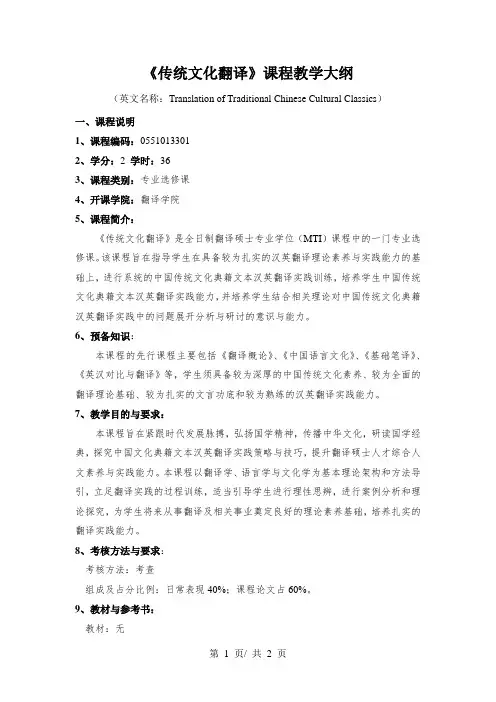
《传统文化翻译》课程教学大纲(英文名称:Translation of Traditional Chinese Cultural Classics)一、课程说明1、课程编码:05510133012、学分:2 学时:363、课程类别:专业选修课4、开课学院:翻译学院5、课程简介:《传统文化翻译》是全日制翻译硕士专业学位(MTI)课程中的一门专业选修课。
该课程旨在指导学生在具备较为扎实的汉英翻译理论素养与实践能力的基础上,进行系统的中国传统文化典籍文本汉英翻译实践训练,培养学生中国传统文化典籍文本汉英翻译实践能力,并培养学生结合相关理论对中国传统文化典籍汉英翻译实践中的问题展开分析与研讨的意识与能力。
6、预备知识:本课程的先行课程主要包括《翻译概论》、《中国语言文化》、《基础笔译》、《英汉对比与翻译》等,学生须具备较为深厚的中国传统文化素养、较为全面的翻译理论基础、较为扎实的文言功底和较为熟练的汉英翻译实践能力。
7、教学目的与要求:本课程旨在紧跟时代发展脉搏,弘扬国学精神,传播中华文化,研读国学经典,探究中国文化典籍文本汉英翻译实践策略与技巧,提升翻译硕士人才综合人文素养与实践能力。
本课程以翻译学、语言学与文化学为基本理论架构和方法导引,立足翻译实践的过程训练,适当引导学生进行理性思辨,进行案例分析和理论探究,为学生将来从事翻译及相关事业奠定良好的理论素养基础,培养扎实的翻译实践能力。
8、考核方法与要求:考核方法:考查组成及占分比例:日常表现40%;课程论文占60%。
9、教材与参考书:教材:无参考书目:《中国文化典籍英译》,王宏印,外语教学与研究出版社(第1版),2009年。
《典籍英译研究》,李正拴、汪榕培,河北大学出版社,2005年。
《新编英汉对比与翻译》,刘宓庆,中国对外翻译出版社,2006年。
《高级英汉翻译理论与实践》,叶子南,清华大学出版社,2008年。
《中国哲学史》,冯友兰,商务印书馆,2011年。
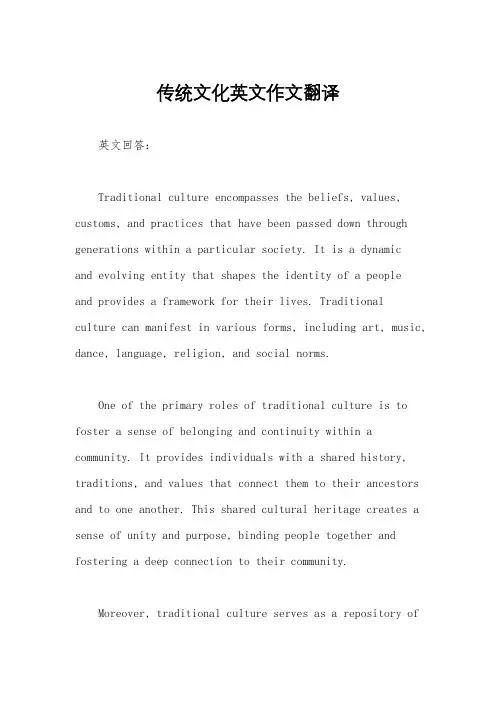
传统文化英文作文翻译英文回答:Traditional culture encompasses the beliefs, values, customs, and practices that have been passed down through generations within a particular society. It is a dynamicand evolving entity that shapes the identity of a peopleand provides a framework for their lives. Traditionalculture can manifest in various forms, including art, music, dance, language, religion, and social norms.One of the primary roles of traditional culture is to foster a sense of belonging and continuity within a community. It provides individuals with a shared history, traditions, and values that connect them to their ancestors and to one another. This shared cultural heritage creates a sense of unity and purpose, binding people together and fostering a deep connection to their community.Moreover, traditional culture serves as a repository ofknowledge and wisdom accumulated over generations. It encompasses a wealth of practical skills, techniques, and beliefs that have been refined and passed down through time. This cultural knowledge enables individuals to navigatetheir lives and adapt to their environment. It provides practical guidance on everything from agriculture and medicine to social etiquette and conflict resolution.In today's rapidly changing world, traditional culture plays a crucial role in preserving cultural diversity and fostering tolerance. In an era of globalization and modernization, it is essential to appreciate and celebrate the unique cultural heritage of different communities. Traditional culture provides a counterbalance to the homogenizing forces of modernity, allowing individuals to maintain their cultural identity and traditions.However, it is important to note that traditionalculture is not static or unchanging. It is constantly evolving and adapting to new circumstances and influences. While it is important to preserve and respect cultural heritage, it is also necessary to allow for cultural changeand innovation. A healthy and vibrant traditional cultureis one that is able to embrace both continuity and adaptation.中文回答:传统文化。
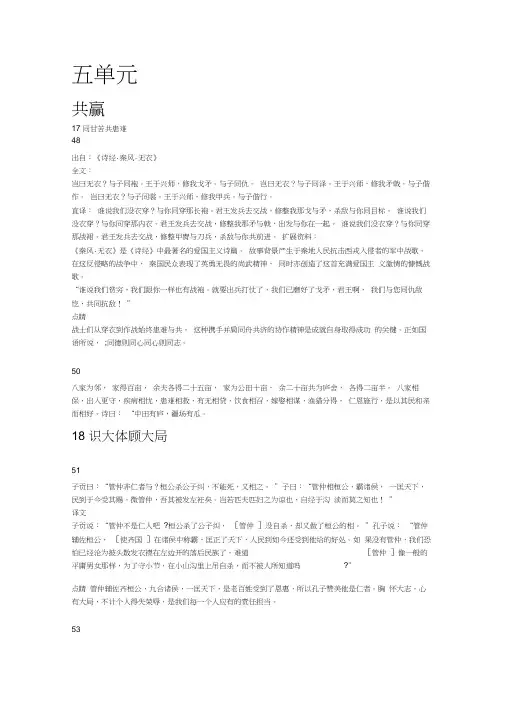
五单元共赢17 同甘苦共患难48出自:《诗经·秦风·无衣》全文:岂曰无衣?与子同袍。
王于兴师,修我戈矛。
与子同仇。
岂曰无衣?与子同泽。
王于兴师,修我矛戟。
与子偕作。
岂曰无衣?与子同裳。
王于兴师,修我甲兵。
与子偕行。
直译:谁说我们没衣穿?与你同穿那长袍。
君王发兵去交战,修整我那戈与矛,杀敌与你同目标。
谁说我们没衣穿?与你同穿那内衣。
君王发兵去交战,修整我那矛与戟,出发与你在一起。
谁说我们没衣穿?与你同穿那战裙。
君王发兵去交战,修整甲胄与刀兵,杀敌与你共前进。
扩展资料:《秦风·无衣》是《诗经》中最著名的爱国主义诗篇。
故事背景产生于秦地人民抗击西戎入侵者的军中战歌。
在这反侵略的战争中,秦国民众表现了英勇无畏的尚武精神,同时亦创造了这首充满爱国主义激情的慷慨战歌。
“谁说我们贫穷,我们跟你一样也有战袍。
就要出兵打仗了,我们已磨好了戈矛,君王啊,我们与您同仇敌忾,共同抗敌!”点睛战士们从穿衣到作战始终患难与共。
这种携手并肩同舟共济的协作精神是成就自身取得成功的关键。
正如国语所说,;同德则同心同心则同志。
50八家为邻,家得百亩,余夫各得二十五亩,家为公田十亩,余二十亩共为庐舍,各得二亩半。
八家相保,出入更守,疾病相忧,患难相救,有无相贷,饮食相召,嫁娶相谋,渔猎分得,仁恩施行,是以其民和亲而相好。
诗曰:“中田有庐,疆场有瓜。
18 识大体顾大局51子贡曰:“管仲非仁者与?桓公杀公子纠,不能死,又相之。
”子曰:“管仲相桓公,霸诸侯,一匡天下,民到于今受其赐。
微管仲,吾其被发左衽矣。
岂若匹夫匹妇之为谅也,自经于沟渎而莫之知也!”译文子贡说:“管仲不是仁人吧?桓公杀了公子纠,[管仲]没自杀,却又做了桓公的相。
”孔子说:“管仲辅佐桓公,[使齐国]在诸侯中称霸,匡正了天下,人民到如今还受到他给的好处。
如果没有管仲,我们恐怕已经沦为披头散发衣襟在左边开的落后民族了。
难道[管仲]像一般的平庸男女那样,为了守小节,在小山沟里上吊自杀,而不被人所知道吗?”点睛管仲辅佐齐桓公,九合诸侯,一匡天下,是老百姓受到了恩惠,所以孔子赞美他是仁者。
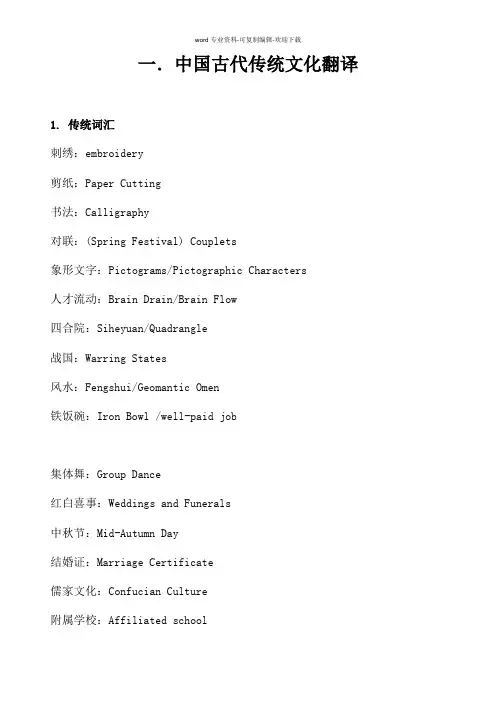
一.中国古代传统文化翻译1. 传统词汇刺绣:embroidery剪纸:Paper Cutting书法:Calligraphy对联:(Spring Festival) Couplets象形文字:Pictograms/Pictographic Characters人才流动:Brain Drain/Brain Flow四合院:Siheyuan/Quadrangle战国:Warring States风水:Fengshui/Geomantic Omen铁饭碗:Iron Bowl /well-paid job集体舞:Group Dance红白喜事:Weddings and Funerals中秋节:Mid-Autumn Day结婚证:Marriage Certificate儒家文化:Confucian Culture附属学校:Affiliated school元宵:Tangyuan/Sweet Rice Dumpling一国两制:One Country, Two Systems火锅:Hot Pot《诗经》:The Book of Songs素质教育:Essential-qualities-oriented Education《史记》:Historical Records/Records of the Grand Historian大跃进:Great Leap Forward (Movement)除夕:Chinese New Year’s Eve/Eve of the Spring Festival中国特色的社会主义:Chinese-charactered Socialist/Socialist with Chinese characteristics孟子:Mencius亭/阁: Pavilion/ Attic大中型国有企业:Large and Medium-sized State-owned Enterprises火药:gunpowder农历:Lunar Calendar京剧:Beijing Opera/Peking Opera太极拳:Tai Chi独生子女证:The Certificate of One-child天坛:Altar of Heaven in Beijing小吃摊:Snack Bar/Snack Stand春卷:Spring Roll(s)追星族:Star Struck故宫博物院:The Palace Museum相声:Cross-talk/Comic Dialogue下岗:Lay off/Laid off北京烤鸭:Beijing Roast Duck烟花爆竹:fireworks and firecracker电视小品:TV Sketch/TV Skit香港澳门同胞:Compatriots from Hong Kong and Macao文化大革命:Cultural Revolution门当户对:Perfect Match/Exact Match中外合资企业:Joint Ventures文房四宝(笔墨纸砚):"The Four Treasure of the Study" "Brush, Inkstick, Paper, and Inkstone"四大名著the Four Great Classical Novels《三国演义》The Romance of the Three Kingdoms 《水浒传》Heroes of the Marshes ; Water Margins 《西游记》Pilgrimage to the West 《红楼梦》Dream of the Red Mansions ; The story of the Stone2.中国意念词八卦trigram阴、阳 yin, yang道 Dao江湖(世界) the jianghu World (the traits’ world)e.g. You can’t control everything in a traits’ world. (人在江湖,身不由己)道 Daoism(Taoism)上火 excessive internal heat儒学 Confucianism红学(《红楼梦》研究) redology世外桃源 Shangri-la or Arcadia大锅饭 getting an equal share regardless of the work done不搞一刀切 no imposing uniformity on …合乎国情,顺乎民意 to conform with the national conditions and the will of the people脱贫 to shake off poverty; anti-poverty3.中华民族的喜庆节日国庆节 National Day中秋节 Mia-Autumn Festival春节 Spring Festival元宵节 Lantern Festival儿童节 Children’s Day端午节 Dragon Boat Festival妇女节 Women’s Day泼水节 Water-Splashing Day五四青年节 Youth Day重阳节:Double-Ninth Festival清明节:Tomb sweeping day4.中国独特的传统饮食馄饨 wonton花卷 steamed twisted rolls套餐 set meal盒饭 box lunch; Chinese take-away米豆腐 rice tofu米粉 rice noodles冰糖葫芦 a stick of sugar-coated haws (or apples,etc.) 粉丝 glass noodles豆腐脑 jellied bean curd5.中国新兴事物中国电信 China Telecom中国移动 China Mobile中国电脑联网 Chinanet三峡工程 the Three Gorges Project 希望工程 Project Hope扶贫工程 Anti-Poverty Project菜篮子工程 Vegetable Basket Project 温饱工程 Decent-Life Project安居工程 Economy Housing Project西部大开发 Go-West Campaign6.特有的一些汉语词汇噱头;掉包袱 gimmick, stunt夜猫子 night people; night-owls本命年 this animal year of sb.处世之道 philosophy of life姻缘 yinyuan(prefixed fate of marriage)7.具有文化特色的现代表述大陆中国 Mainland China红色中国 socialist China四化 Four Modernizations终生职业 job-for-life铁饭碗 iron rice bowl大锅饭 communal pot关系户 closely-related units外出打工人员 migrant workers关系网 personal nets, closely-knitted guild五讲(讲文明、讲礼貌、讲卫生、讲秩序、讲道德):the Five Merits focus on decorum, manners, hygiene, disciplines and morals四美(心灵美、语言美、行为美、环境美): the Four Virtues are golden heart, refined language, civilized behavior, and green environment8.中国古代独特事物宣纸 rice paper衙门 yamen叩头 kowtow孔子Confucius武术 wushu(Chinese Martial Arts)功夫 kungfu ;kung fu中庸 the way of medium (cf. Golden Means)中和 harmony (zhonghe)孝顺 to show filial obedience孝子 dutiful son家长 family head三纲:君为臣纲,父为子纲,夫为妻纲 three cardinal guides: ruler guides subject, father guides son husband guides wife五常:仁、义、理、智、信 five constant virtues: benevolence (humanity), righteousness, propriety, wisdom and fidelity多子多福:The more sons/children, the more blessing/ great happiness 养儿防老:raising sons to support one in one’s old age9.近一季度见诸报端的中国现代特色词汇翻译基层监督 grass-roots supervision婚介所 matrimonial agency婚外恋 extramarital love婚纱摄影 bride photo黑心棉 shoddy cotton机器阅卷 machine scoring集中精力把经济建设搞上去 go all out for economic development加强舆论监督 ensure the correct orientation is maintained in public opinion假帐 accounting fraud叫板 challenge; pick a quarrel矫情 use lame arguments借调 temporarily transfer渐进式台独 gradual Taiwan independence扩大中等收入者比重 Raise the proportion of the middle-income group. 扩大内需,刺激消费expand domestic demand and consumption安居工程 housing project for low-income urban residents 智力密集型 concentration of brain power; knowledge-intensive外资企业 overseas-funded enterprises下岗职工 laid-off workers分流 reposition of redundant personnel三角债 chain debts素质教育 education for all-round development豆腐渣工程 jerry-built projects社会治安情况 law-and-order situation民族国家 nation state西部大开发 Development of the West Regions可持续性发展 sustainable development风险投资 risk investment通货紧缩 deflation扩大内需 to expand domestic demand计算机辅助教学 computer-assisted instruction ( CAI ) 网络空间 cyberspace虚拟现实 virtual reality网民 netizen ( net citizen )电脑犯罪 computer crime电子商务 the e-business网上购物 shopping online应试教育 exam-oriented education学生减负 to reduce study load总裁助理assistant president综合治理comprehensive treatment安居工程housing project for low-income urban residents信息化information-based; informationization智力密集型concentration of brain power; knowledge-intensive外资企业overseas-funded enterprises下岗职工laid-off workers分流reposition of redundant personnel素质教育education for all-round development通货紧缩deflation扩大内需to expand domestic demand计算机辅助教学computer-assisted instruction ( CAI )下海plunge into the commercial sea下网off line小康之家well-off family; comfortably-off family新秀up-and-coming star, rising star新新人类New Human Being ; X Generation形象小姐image representative of a product or a brand虚拟网virtual net学生处students" affairs division研究生毕业证/学位证graduate diploma/graudate degree"sdiploma摇钱树cash cow以人为本people oriented; people foremost义务教育compulsory education易拉罐pop can应试教育examination-oriented education system舆论导向direction of public opinion运球dribble在职博士生on-job doctorate早恋puppy love招生就业指导办公室enrolment and vocation guidance office 证券营业部stock exchange; security exchange知识产权intellectual property rights中专生secondary specialized or technical school student 中流砥柱mainstay, chief corner stone专卖店exclusive agency; franchised store自我保护意识self-protection awareness综合国力comprehensive national strength综合业务数字网integrated service digital network (ISDN) 公正、公平、公开just, fair and open好莱坞大片Hollywood blockbuster黄金时段prime time假唱lip-synch劲射power shot拉拉队cheering squad来电显示电话机caller ID telephone论文答辩(thesis) oral defense泡沫经济bubble economy票贩子scalper, ticket tout拳头产品competitive products; knock-out products;blockbuster三角恋爱love triangle三维动画片three-dimensional animation"扫黄"/"打非" eliminate pornography and illegal publications申办奥运会bid for the Olympic Games实现中华民伟大复兴bring about a great rejuvenation of the Chinese nation市场疲软sluggish market素质教育education for all-around development筒子楼:tube-shaped apartment脱贫致富cast (shake, throw) off poverty and set out on a road to prosperity网吧Internet bar网恋online love affair网上冲浪surf the Internet网上交易平台online trading platform无人售票self-service ticketing二.中国古代特色产品介绍1.酒是中国人生活中的重要饮料之一。
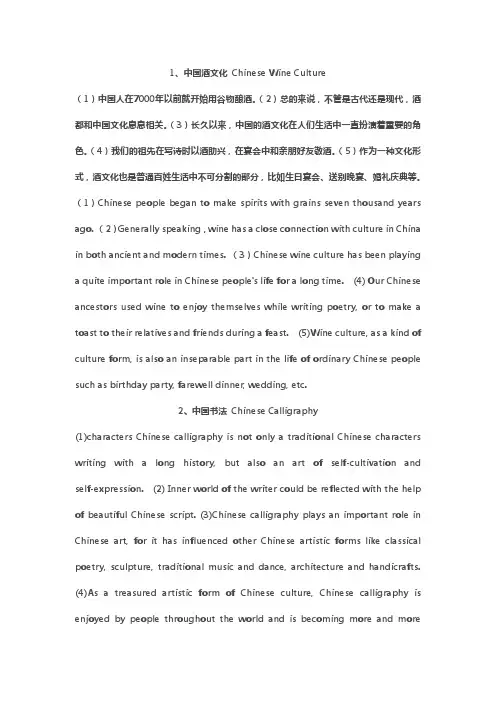
1、中国酒文化Chinese Wine Culture(1)中国人在7000年以前就开始用谷物酿酒。
(2)总的来说,不管是古代还是现代,酒都和中国文化息息相关。
(3)长久以来,中国的酒文化在人们生活中一直扮演着重要的角色。
(4)我们的祖先在写诗时以酒助兴,在宴会中和亲朋好友敬酒。
(5)作为一种文化形式,酒文化也是普通百姓生活中不可分割的部分,比如生日宴会、送别晚宴、婚礼庆典等。
(1)Chinese people began to make spirits with grains seven thousand years ago. (2)Generally speaking,wine has a close connection with culture in China in both ancient and modern times. (3)Chinese wine culture has been playing a quite important role in Chinese people's life for a long time. (4) Our Chinese ancestors used wine to enjoy themselves while writing poetry, or to make a toast to their relatives and friends during a feast. (5)Wine culture, as a kind of culture form, is also an inseparable part in the life of ordinary Chinese people such as birthday party, farewell dinner, wedding, etc.2、中国书法Chinese Calligraphy(1)characters Chinese calligraphy is not only a traditional Chinese characters writing with a long history, but also an art of self-cultivation and self-expression. (2) Inner world of the writer could be reflected with the help of beautiful Chinese script. (3)Chinese calligraphy plays an important role in Chinese art, for it has influenced other Chinese artistic forms like classical poetry, sculpture, traditional music and dance, architecture and handicrafts.(4)As a treasured artistic form of Chinese culture, Chinese calligraphy is enjoyed by people throughout the world and is becoming more and morepopular.(1)中国书法历史悠久,它不仅是汉字的传统书写形式,也是体现自我修养和自我表达的艺术。
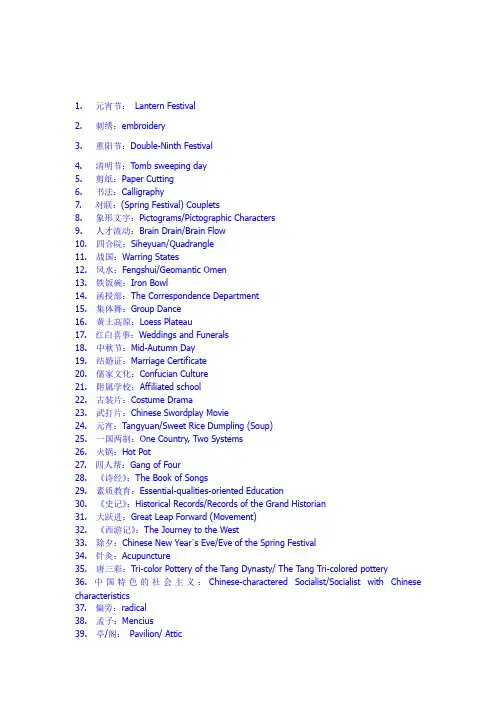
1. 元宵节:Lantern Festival2. 刺绣:embroidery3. 重阳节:Double-Ninth Festival4. 清明节:Tomb sweeping day5. 剪纸:Paper Cutting6. 书法:Calligraphy7. 对联:(Spring Festival) Couplets8. 象形文字:Pictograms/Pictographic Characters9. 人才流动:Brain Drain/Brain Flow10. 四合院:Siheyuan/Quadrangle11. 战国:Warring States12. 风水:Fengshui/Geomantic Omen13. 铁饭碗:Iron Bowl14. 函授部:The Correspondence Department15. 集体舞:Group Dance16. 黄土高原:Loess Plateau17. 红白喜事:Weddings and Funerals18. 中秋节:Mid-Autumn Day19. 结婚证:Marriage Certificate20. 儒家文化:Confucian Culture21. 附属学校:Affiliated school22. 古装片:Costume Drama23. 武打片:Chinese Swordplay Movie24. 元宵:Tangyuan/Sweet Rice Dumpling (Soup)25. 一国两制:One Country, Two Systems26. 火锅:Hot Pot27. 四人帮:Gang of Four28. 《诗经》:The Book of Songs29. 素质教育:Essential-qualities-oriented Education30. 《史记》:Historical Records/Records of the Grand Historian31. 大跃进:Great Leap Forward (Movement)32. 《西游记》:The Journey to the West33. 除夕:Chinese New Year’s Eve/Eve of the Spring Festival34. 针灸:Acupuncture35. 唐三彩:Tri-color Pottery of the Tang Dynasty/ The Tang Tri-colored pottery36. 中国特色的社会主义:Chinese-charactered Socialist/Socialist with Chinese characteristics37. 偏旁:radical38. 孟子:Mencius39. 亭/阁:Pavilion/ Attic40. 大中型国有企业:Large and Medium-sized State-owned Enterprises41. 火药:gunpowder42. 农历:Lunar Calendar43. 印/玺:Seal/Stamp44. 物质精神文明建设:The Construction of Material Civilization and Spiritual Civilization45. 京剧:Beijing Opera/Peking Opera46. 秦腔:Crying of Qin People/Qin Opera47. 太极拳:Tai Chi48. 独生子女证:The Certificate of One-child49. 天坛:Altar of Heaven in Beijing50. 小吃摊:Snack Bar/Snack Stand51. 红双喜:Double Happiness52. 政治辅导员:Political Counselor/School Counselor53. 春卷:Spring Roll(s)54. 莲藕:Lotus Root55. 追星族:Star Struck56. 故宫博物院:The Palace Museum57. 相声:Cross-talk/Comic Dialogue58. 下岗:Lay off/Laid off59. 北京烤鸭:Beijing Roast Duck60. 高等自学考试:Self-taught Examination of Higher Education61. 烟花爆竹:fireworks and firecracker62. 敦煌莫高窟:Mogao Caves63. 电视小品:TV Sketch/TV Skit64. 香港澳门同胞:Compatriots from Hong Kong and Macao65. 文化大革命:Cultural Revolution66. 长江中下游地区:The Mid-low Reaches of Yangtze River67. 门当户对:Perfect Match/Exact Match68. 《水浒》:Water Margin/Outlaws of the Marsh69. 中外合资企业:Joint Ventures70. 文房四宝(笔墨纸砚):"The Four Treasure of the Study" "Brush, Inkstick, Paper, and Inkstone"71.兵马俑:cotta Warriors/ Terracotta Army72.旗袍:cheongsam要了解中国文化,就应该对中国的戏曲文化有所了解。
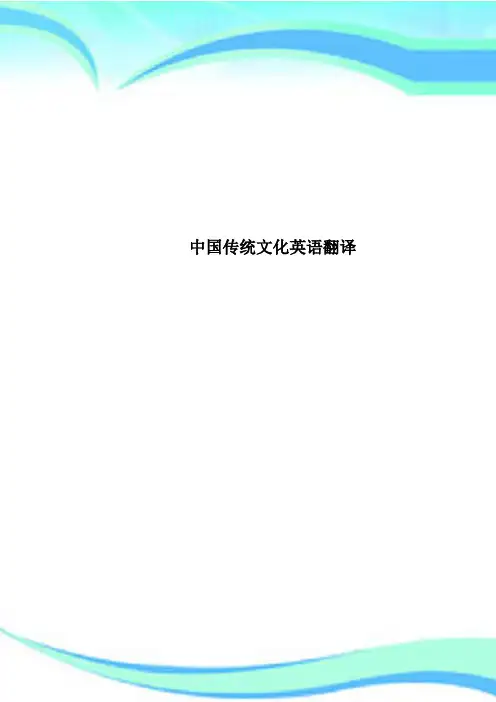
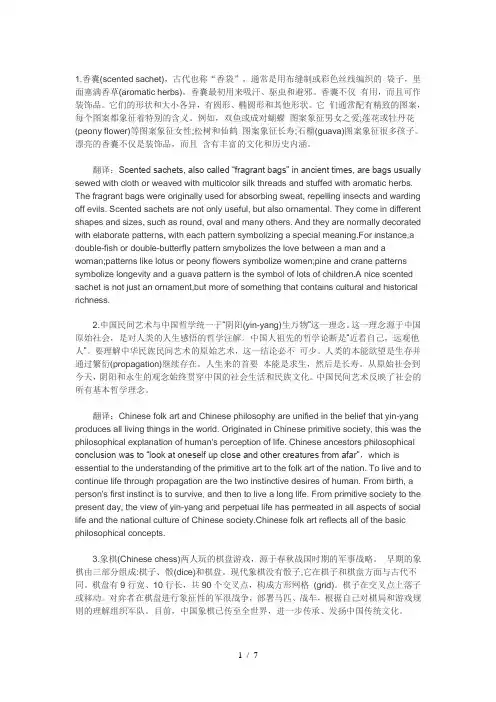
1.香囊(scented sachet),古代也称“香袋”,通常是用布缝制或彩色丝线编织的袋子,里面塞满香草(aromatic herbs)。
香囊最初用来吸汗、驱虫和避邪。
香囊不仅有用,而且可作装饰品。
它们的形状和大小各异,有圆形、椭圆形和其他形状。
它们通常配有精致的图案,每个图案都象征着特别的含义。
例如,双鱼或成对蝴蝶图案象征男女之爱;莲花或牡丹花(peony flower)等图案象征女性;松树和仙鹤图案象征长寿;石榴(guava)图案象征很多孩子。
漂亮的香囊不仅是装饰品,而且含有丰富的文化和历史内涵。
翻译:Scented sachets, also called “fragrant bags” in ancient times, are bags usually sewed with cloth or weaved with multicolor silk threads and stuffed with aromatic herbs. The fragrant bags were originally used for absorbing sweat, repelling insects and warding off evils. Scented sachets are not only useful, but also ornamental. They come in different shapes and sizes, such as round, oval and many others. And they are normally decorated with elaborate patterns, with each pattern symbolizing a special meaning.For instance,a double-fish or double-butterfly pattern smybolizes the love between a man and a woman;patterns like lotus or peony flowers symbolize women;pine and crane patterns symbolize longevity and a guava pattern is the symbol of lots of children.A nice scented sachet is not just an ornament,but more of something that contains cultural and historical richness.2.中国民间艺术与中国哲学统一于“阴阳(yin-yang)生万物”这一理念。
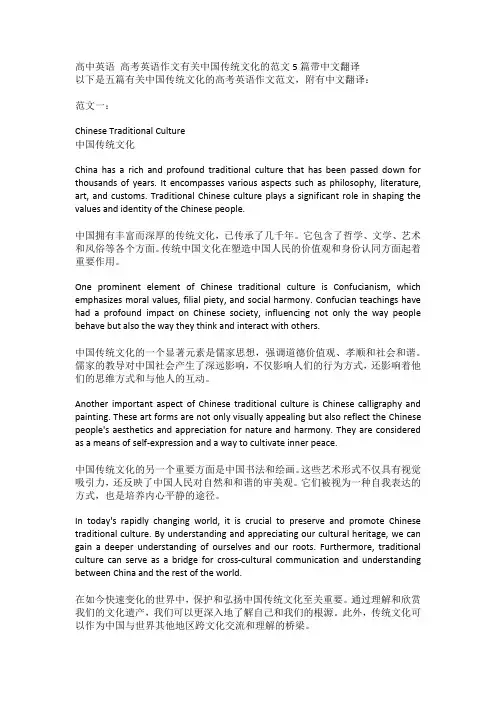
高中英语高考英语作文有关中国传统文化的范文5篇带中文翻译以下是五篇有关中国传统文化的高考英语作文范文,附有中文翻译:范文一:Chinese Traditional Culture中国传统文化China has a rich and profound traditional culture that has been passed down for thousands of years. It encompasses various aspects such as philosophy, literature, art, and customs. Traditional Chinese culture plays a significant role in shaping the values and identity of the Chinese people.中国拥有丰富而深厚的传统文化,已传承了几千年。
它包含了哲学、文学、艺术和风俗等各个方面。
传统中国文化在塑造中国人民的价值观和身份认同方面起着重要作用。
One prominent element of Chinese traditional culture is Confucianism, which emphasizes moral values, filial piety, and social harmony. Confucian teachings have had a profound impact on Chinese society, influencing not only the way people behave but also the way they think and interact with others.中国传统文化的一个显著元素是儒家思想,强调道德价值观、孝顺和社会和谐。
儒家的教导对中国社会产生了深远影响,不仅影响人们的行为方式,还影响着他们的思维方式和与他人的互动。
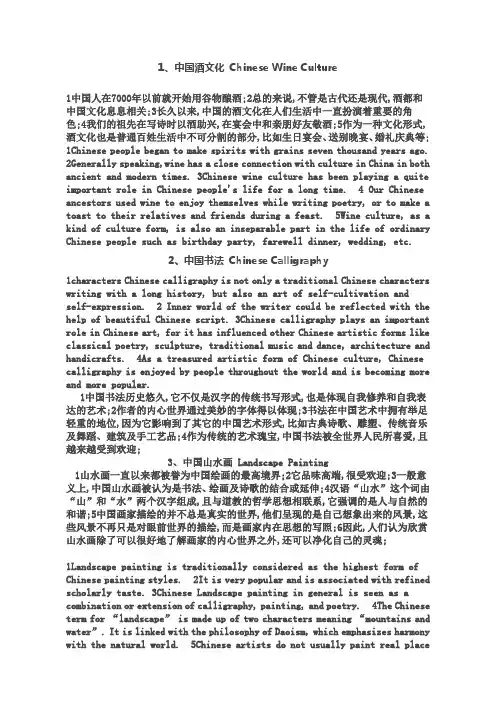
1、中国酒文化Chinese Wine Culture1中国人在7000年以前就开始用谷物酿酒;2总的来说,不管是古代还是现代,酒都和中国文化息息相关;3长久以来,中国的酒文化在人们生活中一直扮演着重要的角色;4我们的祖先在写诗时以酒助兴,在宴会中和亲朋好友敬酒;5作为一种文化形式,酒文化也是普通百姓生活中不可分割的部分,比如生日宴会、送别晚宴、婚礼庆典等; 1Chinese people began to make spirits with grains seven thousand years ago. 2Generally speaking,wine has a close connection with culture in China in both ancient and modern times. 3Chinese wine culture has been playing a quite important role in Chinese people's life for a long time. 4 Our Chinese ancestors used wine to enjoy themselves while writing poetry, or to make a toast to their relatives and friends during a feast. 5Wine culture, as a kind of culture form, is also an inseparable part in the life of ordinary Chinese people such as birthday party, farewell dinner, wedding, etc.2、中国书法Chinese Calligraphy1characters Chinese calligraphy is not only a traditional Chinese characters writing with a long history, but also an art of self-cultivation andself-expression. 2 Inner world of the writer could be reflected with the help of beautiful Chinese script. 3Chinese calligraphy plays an important role in Chinese art, for it has influenced other Chinese artistic forms like classical poetry, sculpture, traditional music and dance, architecture and handicrafts. 4As a treasured artistic form of Chinese culture, Chinese calligraphy is enjoyed by people throughout the world and is becoming more and more popular.1中国书法历史悠久,它不仅是汉字的传统书写形式,也是体现自我修养和自我表达的艺术;2作者的内心世界通过美妙的字体得以体现;3书法在中国艺术中拥有举足轻重的地位,因为它影响到了其它的中国艺术形式,比如古典诗歌、雕塑、传统音乐及舞蹈、建筑及手工艺品;4作为传统的艺术瑰宝,中国书法被全世界人民所喜爱,且越来越受到欢迎;3、中国山水画 Landscape Painting1山水画一直以来都被誉为中国绘画的最高境界;2它品味高端,很受欢迎;3一般意义上,中国山水画被认为是书法、绘画及诗歌的结合或延伸;4汉语“山水”这个词由“山”和“水”两个汉字组成,且与道教的哲学思想相联系,它强调的是人与自然的和谐;5中国画家描绘的并不总是真实的世界,他们呈现的是自己想象出来的风景,这些风景不再只是对眼前世界的描绘,而是画家内在思想的写照;6因此,人们认为欣赏山水画除了可以很好地了解画家的内心世界之外,还可以净化自己的灵魂;1Landscape painting is traditionally considered as the highest form of Chinese painting styles. 2It is very popular and is associated with refined scholarly taste. 3Chinese Landscape painting in general is seen as a combination or extension of calligraphy, painting, and poetry. 4The Chinese term for “landscape” is made up of two characters meaning “m ountains and water”. It is linked with the philosophy of Daoism, which emphasizes harmony with the natural world. 5Chinese artists do not usually paint real placebut imaginary landscape which is no longer about the description of the visible world, but a means of conveying the inner mind. 6People therefore believe that looking at landscape painting is a good way to realize the artist’s inner heart as well as a way to purify their souls.4、中国戏曲 Chinese Opera1在中国,戏曲是一种很流行的戏剧形式,一般来说,可以追溯到唐朝时期,当时的皇帝唐玄宗创立了“梨园”;2如今,许多外国人也很喜欢中国的戏曲;3最吸引他们的则是戏曲的独有风格—画脸谱,它不仅是戏曲中的一大亮点,同时还要求独特的绘画技艺;4每个演员脸上夸张的扮相代表其扮演角色的性格和命运;5熟知戏曲的观众通过观察演员的脸谱和服装就可以知道角色背后的故事;6通常,红色脸谱代表忠诚与勇敢;黑色代表凶猛;黄色和白色代表口是心非;金色和银色代表神秘;7对于中国人,特别是老年人,欣赏戏曲是他们的一大乐趣;1Chinese opera is a popular form of drama in China. In general, it dates back to the Tang Dynasty with Emperor Xuanzong, who founded the “Pear Garden”. 2Now Chinese opera is warmly welcomed by many foreign people. 3What appeals foreigners most might be the distinctive style of facial make-up, which is one of the highlights and requires distinctive techniques of painting.4Exaggerated designs are painted on each performer's face to symbolize a character's personality, and fate. 5Audiences who are familiar with opera can know the story by observing the facial painting as well as the costumes. 6Generally, a red face represents loyalty and bravery; a black face, rough ; yellow and white faces, duplicity; and golden and silver faces, mystery. 7For Chinese, especially older folks, to listen to opera is a real pleasure.5、京剧 Peking Opera1京剧是中国的一种传统艺术;2它是中国戏曲的一种,诞生于于1790年四大徽班Four Great Anhui Troupes入京表演的时候;19世纪中期得到快速发展,到清朝达到全盛阶段;3京剧被看成是中国的文化瑰宝之一;4虽然它被称为京剧,但是它的起源地却是中国的安徽省和湖北省;5京剧起初是一种宫廷表演艺术,而后才慢慢普及到民间;6在数百年前,京剧作为一种新的戏曲形式,无论在哪里进行表演,都饱受欢迎;7而在现代社会中,包括京剧在内的传统戏曲却不大能被年轻人接受,面临着巨大的生存危机;1Peking opera is a traditional art in China. 2It is a kind of Chinese opera which was born when the Four Great Anhui Troupes came to Beijing in 1790, arose in the mid-19th century and was extremely popular in the Qing Dynasty. 3Peking opera is widely regarded as one of the cultural treasures of China. 4Although it is called Beijing opera, its origins are in the Chinese provinces of Anhui and Hubei. 5Peking opera was originally staged for the court and came into the public later. 6Hundreds of years ago, as a new drama form, wherever it was performed, it would be warmly welcomed. 7Unfortunately, in the modern world, traditional operas including Peking Opera have to face the existential crisis, because they are not easily accepted by younger generations.6、昆曲 Kunqu Opera1昆曲是中国古老戏曲中的一种,起源于江苏昆山,拥有600多年的历史;2它是连接过去与现在,中国与世界的纽带,对现今中国的戏曲形式,包括川剧与京剧在内,都产生了重要的影响; 3昆曲蕴含了各种意象美,从音乐、舞蹈到诗歌,人们的精神世界甚至中国人的灵魂,都有所体现;4正因为如此,昆曲在过去广受欢迎,也成了中国文化遗产中最珍贵的部分;5但是现在,昆曲不仅面临着来自大众流行文化的挑战,而且年轻人也对其缺乏兴趣;6只有进行适当的保护,昆曲才能拥有美好的未来;1Kunqu Opera, which originated in the Kunshan region of Jiangsu province, is one of China’s classical operas with a history of more than 600 years. 2Kunqu Opera serves as a link between past and present, China and the world. It has exerted a dominant influence on recent forms of opera in China, including the Sichuan and Beijing operas. 3Kunqu Opera embraced every imaginable beauty, from music and dance, to poetry and people’s spirit world and even very soul of the Chinese nation. 4so that Kunqu Opera was so popular in the past and became the most valuable part s of China’s cultural heritage.5But now, Kunqu Opera is facing competition from mass culture and a lack of interest amongst the young. 6It can only have a bright future when it is protected in a proper way.7、唐诗 Poems of the Tang Dynasty1唐代,是中国古典诗歌的鼎盛时期,在不到300年的时间里,涌现出了许多着名的诗人和诗作;2清朝时编辑的全唐诗Poems of the Tang Dynasty已收录2200多位诗人创作的48900多首诗歌;3这些诗歌让人们深入了解到当时社会生活的各个方面;4中国人很喜欢唐诗,就连小孩子也能背出几首,如李白的静夜思Thoughts in the Silent Night,杜甫的春夜喜雨Good Rain on a Spring Night等等;5唐诗不仅是中国古代文学史上最光辉的一页,而且也是人类文化史中的一个奇迹;1The Tang Dynasty witnessed the peak of Chinese ancient poetry, with many renowned poets and famous works appearing over a period of less than 300 years. 2Poems of the Tang Dynasty edited during the Qing Dynasty has collected more than 48,900 poems written by over 2,200 poets. 3These poems provide an insight into all aspects of the social life of the period. 4Chinese people are very fond of Tang poetry, and even children can recite some from memory, such as Thoughts in the Silent Night by Li Bai, Good Rain on a Spring Night by Du Fu, etc.5Tang poetry not only serves as a most brilliant page in the history of ancient Chinese literature, but is also a miracle in the history of human culture.8、中国武术Chinese Martial Arts/ Kungfu1中国武术拥有悠久的历史,在中国广为流行;2 受中国古典美学所提倡的刚柔并济的影响,,中国武术形成了自己的审美标准;3现在很多人习武是为了健康、娱乐和竞技;4为了更好地传承这一古老的技艺,全国各地开设有很多的武术俱乐部和协会;5自1980年起,一大批武术专业的毕业生被分配到学校里教授武术;6现在很多专家通过将搏斗技巧和健康结合到一起,试着将武术变为一项科学的运动;7他们希望有一天,武术可以作为一项赛事纳入奥运会中;1Chinese martial arts enjoy a long history and great popularity in China. 2Influenced by ancient Chinese aesthetics which advocated a balance between hardness and softness, Chinese martial arts have formed their own aesthetic standards. 3Today, many people practice it to pursue health, entertainment and competition. 4In order to inherit the ancient art, many martial arts clubs and associations have been established across China. 5Since 1980, a large number of graduates majoring in martial arts have been assigned to teach martial arts in schools. 6Many specialists today are tying to turn martialarts into a scientific sport by combining fighting skills with health. 7They hope that one day martial arts will become a sport event at the Olympic Games.9、长城 The Great Wall1长城,作为中国的象征之一,不仅是中国的奇迹,也是整个世界的奇迹;2它始建于春秋战国时期,秦始皇统一中国后,连结了各段长城以抵御外敌入侵;3现存的长城遗迹主要为建于14世纪的明长城;4长城有着两千多年的历史,于1987年被联合国教科文组织列为世界遗产;5现如今,长城仍是世界上最受欢迎的景点之一;1As one of the symbols of China, the Great Wall is a wonder not only to China but also to the whole world. 2The Great Wall was first built in the Spring and Autumn Period and the Warring States Period. After the unification of China, the first Emperor of Qin linked up different sections of the walls to prevent the invasion of the enemies. 3The present preserved Great Wall of China is the major parts built in the 14th century, called Ming Great Wall. 4With a long history of more than 2,000 years, the Great Wall of China was listed as World Heritage by UNESCO in 1987. 5Until now, the Great Wall is still one of the most popular attractions in the world.10、故宫 The Imperial Palace1故宫又名紫禁城,位于北京市中心,占地面积72万平方米;2它拥有众多的庭院,四面有高墙和护城河保护;3明清两代的皇帝和他们的家眷以及数百名宫女、太监曾在这里居住;4紫禁城于明朝1420年建成,普通百姓不能进入;5在1924年清朝末代皇帝被逐出故宫后,故宫于1925年变成了故宫博物院并对外开放;1Standing/Lying in the center of Beijing, the Imperial Palace, also known as the Forbidden City, covers an area of 720,000 square meters. 2It consists of dozens of courtyards and is protected by high walls and a moat on all four sides. The emperors of two dynasties. 3the Ming and the Qing, lived here with their families and hundreds of court ladies and palace eunuchs. 4The Forbidden City was completed in 1420 during the Ming Dynasty, which was not accessible to the common people. 5The Palace was converted into a museum in 1925 and has been open to the public after the last emperor of the Qing Dynasty was driven out of the Palace in 1924.。
中国传统文化名称英语翻译我们学了英语,需要用英文介绍中国的美食和文化时,是否常常困惑怎么准确地翻译中国传统文化名词?比如火锅、羊肉泡馍、小笼包、豆腐脑?比如《诗经》、《史记》、《红楼梦》、《西游记》?现在中国传统文化名词英语翻译来了,一起来学习起来吧!1、元宵节:Lantern Festival2、刺绣:Embroidery3、重阳节:Double-Ninth Festival4、清明节:Tomb sweeping day5、剪纸:Paper Cutting6、书法:Calligraphy7、对联:Couplet8、象形文字:Pictograms,/Pictographic Characters9、雄黄酒:Realgar wine10、四合院:Siheyuan,/Quadrangle11、战国:Narring States12、风水:Fengshui/Geomantic Omen13、昱曲:Kunqu Opera14、长城:The Great Wall15、集体舞:Group Dance16、黄土高原:Loess Plateau17、红白喜事:Neddings and Funerals18、中秋节:Mid-autumn Day19、花鼓戏:Flower Drum Song2O、儒家文化:Confucian Culture21、中国结:Chinese Knotting22、古装片:Costume Drama23、武打片:Chinese Swordplay Movie24、元宵:Tangyuan/Sweet Rice Dumpling25、越剧:Yue Opera26、火锅:Hot Pot27、江南:South Regions of the Yangtze River28、《诗经》:The Book of Songs29、谜语:Riddle3O、《史记》:Historical Records,/Records of theGrand Historian31、《红楼梦》:A Dream of Red Mansions32、《西游记》:The Journey to the West33、除夕:Chinese New Year’sEve/Eve of theSpring Festival34、针灸:Acupuncture35、唐三彩:Tri-color Pottery of Tang Dynas-ty/The Tang Tri-color Pottery36、二人车转:Errenzhuan37、偏旁:Radical38、孟子:Mencius39、亭/阁:Pavilion/Attic40、黄梅戏:Huangmei opera41、火药:Gunpowder42、农历:Lunar Calendar43、印/玺:Seal/Stamp44、腊八节:The laba Rice Porridge Festival45、京剧:Beijing Opera/Peking Opera46、秦腔:Qin Opera47、太极拳:Tai Chi48、《本草纲目》:Compendium of Materia Medica49、天坛:Temple of Heaven5O、小吃摊:Snack Bar/Snack Stand51、红双喜:Double Happiness52、文房四宝:The Four Treasures of the Study、笔墨纸砚:Brush,Inkstick,Paper,and Inkstone53、春卷:Spring Roll(s)54、莲藕:Lotus Root55、《三国演义》:The Romance of Three Kingdoms56、故宫博物院:The Palace Museum57、相声:Cross-talk/Comic Dialogue58、五行:Five Elements59、北京烤鸭:Beijing Roast Duck60、《桃花扇》:The Peach Blossom Fan61、木偶戏:Puppet Show62、敦煌莫高窟:Mogao Caves63、电视小品:TV Sketch/TV Skit64、甲骨文:Oracle Bone Inscriptions65、古筝:Chinese Zither66、二胡:Urheen67、门当户对:Perfect Match/Exact Match68、《水浒》:Water Margin,/Outlaws of the Marsh69、炸酱面:Noodles with Bean Paste7O、国子监:Imperial Academy71、兵马俑:Cotta Warriors,/Terracotta Army72、旗袍:Cheongsam73、指南针:Compass74、泼水节:Water-Splashing Day75、馄饨:Wonton76、花卷:Steamed twisted rolls77、羊肉泡馍:Pita Bread Soaked in Lamb Soup78、冰糖葫芦:A stick of sugar--coated haws79、八宝饭:Eight--treasure rice pudding80、粉丝:Chinese Vermicelli81、豆腐脑:Jellied bean curd82、小品:Witty Skits83、孝顺:To show filial obedience84、武术:NuShu(Chinese Martial Arts)85、宣纸:Rice Paper86、衙门:Yamen87、叩头:Kowtow88、中庸:The way of medium(cf.Golden Means)89、牌楼:Pailou(pai-loo)90、东坡肉:Dongpo Pork91、中山陵:The Sun Yat--sen Mausoleum92、秦淮河:Qinhuai River93、玄武湖:Xuanwu Lake94、夫子庙:The Confucian Temple95、甲鸭血粉丝:Chinese Vermicelli Cooked withDuck Blood96、盐水鸭:Yanshuiya,or boiled salted duck97、大煮千丝:Raised Shredded Chicken with Hamand Dried Tofu98、小笼包:Steamed buns99、明孝陵:Ming Tomb100、云锦:Nanjing brocade。
中国传统文化中英文翻译1.元宵节:Lantern Festival2.刺绣:embroidery3.重阳节:Double-Ninth Festival4.清明节:Tomb sweeping day5.剪纸:Paper Cutting6.书法:Calligraphy7.对联:(Spring Festival) Couplets8.象形文字:Pictograms/Pictographic Characters9.人才流动:Brain Drain/Brain Flow10.四合院:Siheyuan/Quadrangle11.战国:Warring States12.风水:Fengshui/Geomantic Omen13.铁饭碗:Iron Bowl14.函授部:The Correspondence Department15.集体舞:Group Dance16.黄土高原:Loess Plateau17.红白喜事:Weddings and Funerals18.中秋节:Mid-Autumn Day19.结婚证:Marriage Certificate20.儒家文化:Confucian Culture21.附属学校:Affiliated school22.古装片:Costume Drama23.武打片:Chinese Swordplay Movie24.元宵:Tangyuan/Sweet Rice Dumpling (Soup)25.一国两制:One Country, Two Systems26.火锅:Hot Pot27.四人帮:Gang of Four28.《诗经》:The Book of Songs29.素质教育:Essential-qualities-oriented Education30.《史记》:Historical Records/Records of the Grand Historian31.大跃进:Great Leap Forward (Movement)32.《西游记》:The Journey to the West33.除夕:Chinese New Year’s Eve/Eve of the Spring F estival34.针灸:Acupuncture35.唐三彩:Tri-color Pottery of the Tang Dynasty/ The Tang Tri-colored pottery36.中国特色的社会主义:Chinese-charactered Socialist/Socialist with Chinese characteristics37.偏旁:radical38.孟子:Mencius39.亭/阁:Pavilion/ Attic40.大中型国有企业:Large and Medium-sized State-owned Enterprises41.火药:gunpowder42.农历:Lunar Calendar43.印/玺:Seal/Stamp44.物质精神文明建设:The Construction of Material Civilization and Spiritual Civilization45.京剧:Beijing Opera/Peking Opera46.秦腔:Crying of Qin People/Qin Opera47.太极拳:Tai Chi48.独生子女证:The Certificate of One-child49.天坛:Altar of Heaven in Beijing50.小吃摊:Snack Bar/Snack Stand51.红双喜:Double Happiness52.政治辅导员:Political Counselor/School Counselor53.春卷:Spring Roll(s)54.莲藕:Lotus Root55.追星族:Star Struck56.故宫博物院:The Palace Museum57.相声:Cross-talk/Comic Dialogue58.下岗:Lay off/Laid off59.北京烤鸭:Beijing Roast Duck60.高等自学考试:Self-taught Examination of Higher Education61.烟花爆竹:fireworks and firecracker62.敦煌莫高窟:Mogao Caves63.电视小品:TV Sketch/TV Skit64.香港澳门同胞:Compatriots from Hong Kong and Macao65.文化大革命:Cultural Revolution66.长江中下游地区:The Mid-low Reaches of Yangtze River67.门当户对:Perfect Match/Exact Match68.《水浒》:Water Margin/Outlaws of the Marsh69.中外合资企业:Joint Ventures70.文房四宝(笔墨纸砚):"The Four Treasure of the Study" "Brush, Inkstick, Paper, and Inkstone"71.兵马俑:cotta Warriors/ Terracotta Army。
五单元共赢17 同甘苦共患难48出自:《诗经·秦风·无衣》全文:岂曰无衣?与子同袍。
王于兴师,修我戈矛。
与子同仇。
岂曰无衣?与子同泽。
王于兴师,修我矛戟。
与子偕作。
岂曰无衣?与子同裳。
王于兴师,修我甲兵。
与子偕行。
直译:谁说我们没衣穿?与你同穿那长袍。
君王发兵去交战,修整我那戈与矛,杀敌与你同目标。
谁说我们没衣穿?与你同穿那内衣。
君王发兵去交战,修整我那矛与戟,出发与你在一起。
谁说我们没衣穿?与你同穿那战裙。
君王发兵去交战,修整甲胄与刀兵,杀敌与你共前进。
扩展资料:《秦风·无衣》是《诗经》中最著名的爱国主义诗篇。
故事背景产生于秦地人民抗击西戎入侵者的军中战歌。
在这反侵略的战争中,秦国民众表现了英勇无畏的尚武精神,同时亦创造了这首充满爱国主义激情的慷慨战歌。
“谁说我们贫穷,我们跟你一样也有战袍。
就要出兵打仗了,我们已磨好了戈矛,君王啊,我们与您同仇敌忾,共同抗敌!”点睛战士们从穿衣到作战始终患难与共。
这种携手并肩同舟共济的协作精神是成就自身取得成功的关键。
正如国语所说,;同德则同心同心则同志。
50八家为邻,家得百亩,余夫各得二十五亩,家为公田十亩,余二十亩共为庐舍,各得二亩半。
八家相保,出入更守,疾病相忧,患难相救,有无相贷,饮食相召,嫁娶相谋,渔猎分得,仁恩施行,是以其民和亲而相好。
诗曰:“中田有庐,疆场有瓜。
18识大体顾大局51子贡曰:“管仲非仁者与?桓公杀公子纠,不能死,又相之。
”子曰:“管仲相桓公,霸诸侯,一匡天下,民到于今受其赐。
微管仲,吾其被发左衽矣。
岂若匹夫匹妇之为谅也,自经于沟渎而莫之知也!”译文子贡说:“管仲不是仁人吧?桓公杀了公子纠,[管仲]没自杀,却又做了桓公的相。
”孔子说:“管仲辅佐桓公,[使齐国]在诸侯中称霸,匡正了天下,人民到如今还受到他给的好处。
如果没有管仲,我们恐怕已经沦为披头散发衣襟在左边开的落后民族了。
难道[管仲]像一般的平庸男女那样,为了守小节,在小山沟里上吊自杀,而不被人所知道吗?”管仲辅佐齐桓公,九合诸侯,一匡天下,是老百姓受到了恩惠,所以孔子赞美他是仁者。
中国传统文化 Traditional Chinese Culture1 书法艺术 The Art of Calligraphy2 中国 _画的含意 The Significance of Chinese Paintings3 重新发现孔子 Rediscover Confucius4 中医和西医的差异 Differences between Chinese and Western Medicines5 戏曲的作用 The Role of Operas6 中国人崇尚的颜色:黄和红China’s Favorite Color: Yellow &Red:7 筷子的重要性 The Importance of Chopsticks8 茶的格调 The Elegance of Tea Drinking1.书法艺术 The Art of Calligraphy有批评家指出,不同的书法风格有不同的政治寓意。
拿王羲之的书体来说。
他的书法在他有生之年被批评为非正统的书体,然而在他去世几十年之后又被认为是正统的书体。
Some critics suggest that different genres of Chinese calligraphy have different political implications. Take Wang Xizhi for an example. His calligraphy was repudiated as unorthodox during his lifetime but, only a few decades after his death, was established as an orthodox genre.从历史上看,中国书法和政治紧密相连。
2000多年前,秦始皇建立了官方的汉字体系。
新的简化文字使得书法不那么复杂了。
它允许人们使用带有更多直笔的文字,因此用毛笔写起来更加容易。
1) 聪明人防患于未然, 愚蠢者临渴掘井。
2) 前事不忘,后事之师。
前人栽树,后人乘凉。
3) 前不见古人,后不见来者。
念天地之悠悠,独怆然而涕下。
Looking back, I do not see the ancients, Looking ahead, I can‟t see the wise ones to come.Brooding on the endless universe. Alone, in my sorrow, tears stream down.Where are the great men of the past?And where are those of future years?The sky and earth forever last,Here and now I alone shed tears.The core values of socialismCountry: prosperity democracy civilization harmonySociety : freedom equality justice legislationIndividual: patriotism dedication trustworthiness friendliness.1匡超人听了这话,慌忙作揖,磕下头去,说道:“晚生真乃…有眼不识泰山‟。
”When Kung Chao-jen heard this, he made haste to bow. “Although I have eyes,” he exclaimed, “I have failed to see Mount Tai!”2.“恕老衲眼拙,娘子是不是……”“Excuse my poor eyesight,” said the monk, “you are…?”3.今天饭菜不好,请多包涵。
来,先干一杯。
They are the best dishes we‟re able to prepare. Please make yourself at home. Now, to everyone, cheers!4.水平有限,书中错误或不妥之处在所难免,敬请读者批评指正。
中国传统文化名词的英语表达,翻译、写作都可以用到!1.元宵节:Lantern Festival2.刺绣:Embroidery3.重阳节:Double-Ninth Festival4.清明节:Tomb sweeping day5.剪纸:Paper Cutting6.书法:Calligraphy7.对联:(Spring Festival) Couplets8.象形文字:Pictograms/Pictographic Characters9.雄黄酒:Realgar wine10.四合院:Siheyuan/Quadrangle11.战国:Warring States12.风水:Fengshui/Geomantic Omen13.昆曲:Kunqu Opera14.长城:The Great Wall15.集体舞:Group Dance16.黄土高原:Loess Plateau17.红臼喜事:Weddings and Funerals18.中秋节:Mid-Autumn Day19.花鼓戏:Flower Drum Song20.儒家文化:Confucian Culture21.中国结:Chinese knotting22.古装片:Costume Drama23.武打片:Chinese Swordplay Movie24.元宵:Tangyuan/Sweet Rice Dumpling (Soup)25.越剧:Yue Opera26.火锅:Hot Pot27.江南:South Regions of the Yangtze River28.《诗经》:The Book of Songs29.谜语:Riddle30.《史记》:Historical Records/Records of the Grand Historian31.《红楼梦》:A Dream of Red Mansions32.《西游记》:The Journey to the West33.除夕:Chinese New Year’s Eve/Eve of the Spring Festival34.针灸:Acupuncture35.唐三彩:Tri-color Pottery of the TangDynasty/ The Tang Tr。
英语翻译Unit 1Book 3.中国传统节日以中国的农历为依据。
农历年的岁首称为春节,俗称“过年”,有祈年等多种习俗,是中国人民最隆重的传统节日,象征团结兴旺。
其他主要的节日有元宵节、清明节、端午节、七夕节、中秋节、重阳节、冬至节、腊八节等等。
各个节日都有其来源讲究和风俗习惯。
农历节日与农历中的二十四节气不同。
农历节日是中华民族凝聚力和生命力的体现Traditional Chinese festivals are usually fixed to the Lunar calendar. Jan uary 1st on the lunar calendar has been designated as the Spring Festival ( generally referred to as guonian). There are several customs during the Sp ring Festival, such as praying for a good harvest, etc. The Spring Festival is the most ceremonious traditional festival in China and symbolizes unity and prosperity. Some other significant Chinese festivals include the Lant ern Festival, the Pure Bright Festival, the Dragon Boat Festival. the Doub le-Seventh Festival, the Mid-Autumn Festival, the Double-Ninth Festival, the Winter Solstice, and the Eight Day of the Twelfth Lunar Month, etc. Each festival has its own unique origin and custom. These Chinese festiva ls that follow teh Lunar calendar are different from the 24 Solar Terms in theLunar calendar. They embody China's cohesion and vitality.Unit 2 Book 3.茶是中华民族的举国之饮,发端于神农,兴盛于唐宋(618-1279)。
开门七件事,柴米油盐酱醋茶,是中国人日常生活的写照。
茶文化是茶的自然和人文双重属性的引申与概括。
中国的茶道精神将儒释道三教融入其中,其主要目的是借助饮茶艺术来修炼身心,体悟大道,提升人生境界。
Chinese Tea CultureAs a traditional drink for Chinese people, Chinese tea is believed to have first started with Chinese Emperor Shen Nong, and flourished in the Tang and Song Dynasties. Making tea was considered one of the seven basic d aily necessities along with fuel, rice, oil, salt, soy sauce, and vinegar, whil e drinking tea is an apt portrayal of daily life in China. Tea culture is the e xtension and generalization of the science and the humanities character of tea. In China, the tea spirit blends the thoughts of Confucianism, Buddhis m, and Taoism, and it aims to help people cultivate both mind and body, c omprehend the truth, and elevat the realm of life through the art of drinki ng tea.Unit 3Book3.中国古代四大艺术“琴棋书画”的画特指国画。
其绘画形式是用毛笔蘸水、墨、颜料作画于绢、帛、宣纸之上,古代称之为水墨丹青。
为区别于西方的油画而称之为“中国画”,简称“国画”。
其题材有人物、山水、花鸟等。
技法可分为工笔和写意。
国画的艺术特质在于“笔墨”,强调以形写神,画尽意在。
国画在艺术创作上反映了中化民族的审美意识和情趣。
The four art forms in ancient China are guqin, chess, penmanship, and pai nting. And painting particularly refers to traditional Chinese painting. Tra ditional Chinese painting is done with a brush dipped into black or colored ink and is painted on silk or xuan paper. In ancient China, it was called “ink-painting.” In order to distinguish it from Western oil-paintings, the Chinese people term their works “traditional Chinese painting” (abbr eviated to “Chinese painting”.) The subject matters of Chinese painting s are typically figures, landscapes, birds and flowers. The drawing skills a nd techniques employed by the Chinese painters can be divided into two f orms: fine brushwork and free-hand brushwork. The artistic characteristic s lie in “the writing brush and ink.” Chinese painting emphasizes using the shape to convey the feelings of the painter. Even though a painting is a finished product, it endlessly conveys a meaning. In terms of the artistic creation, traditional Chinese painting is a reflection of the aesthetic consc iousness and artistic sentiment of the Chinese people.Unit 4Book3 .中国是酒的故乡。
古人将酒的作用归纳为治病、养生、礼仪三类。
酒文化是中华饮食文化的重要组成部分,它的精神文化价值体现在社会政治生活、文学艺术乃至人生态度、审美情趣等诸多方面。
无酒不成宴,酒筹文化是中国合餐制的产物。
宴席上的酒令五花八门,猜拳、文字令、筹令等都富有丰富的文化内涵,若胸中无数,则难以自如应对。
China is the home of wine and spirits. The functions of wine and spirits w ere classified by the ancients into three kinds: treating patients, keeping in good health, and showing politeness and respect to others. China's wine a nd spirits culture is an important part of Chinese food culture, and it embodies its valuesin many aspects, such as in social and political life, literature and art, life philosophies, aesthetics, and so on. There is an old saying which goes, " It is not a banquet without wine." Under the custom of having dinner toget her in China, drinking games were therefore introduced. There are many kinds of banquet betting and drinking games, like the morra ( a finger-gue ssing game), wine/spirtis words, wine/spirits chips (a drinking game), all with rich cultural connotations. In reality, it is difficult to win unless you have a card up your sleeve.5. 中国石窟中国石窟组要反映的是佛教文化艺术。
敦煌莫高窟、大同云冈石窟、洛阳龙门石窟、天水麦积山石窟,号称中国四大石窟艺术景观。
佛教石窟随山雕凿、彩绘,形象生动自然,将崇尚美与世俗情融为一体,把天然造化与人工创造有机结合,是由建筑、绘画、雕塑等组成的博大精深、绚丽夺目的综合艺术殿堂。
其艺术成就为世界瞩目,已成为重要的世界文化遗产。
Chinese GrottoesChinese grottoes mainly reflect the art of Buddhist culture. In China,there are four major art landscape of grottoes:the Mogao Grottoes at Dunhuang, the Y ungang Grottoes at Datong, the Longmen Grottoes at Luoyang, and the Maijishan Grottoes at Tianshui. Carved and painted on mountains, the Buddhist grottoes mingle both sublimity and secularfeelings together, presenting us a vivid and natural appearance. They embody the systematic combination of both the exceptional artistry of great nature and the extremely fine craftsmanship of mankind. The Chinese Buddhist Grottoes are regarded as a profound and stunning general art gallery, which are composed of architecture, painting, sculptures, etc. The artistic achievements of Chinese grottoes have attracted the attention of the world, and have become important international cultural heritage.Unit 6 Book3. 中国古典文学名著中国古典文学包括诗歌、散文、小说以及词、赋、曲等多种文体,艺术表现手法丰富各异。